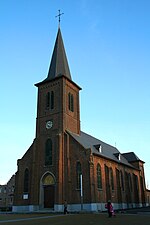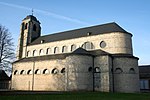Binche

Binche (French pronunciation: [bɛ̃ʃ] ; Walloon: Bince; Dutch: Bing) is a city and municipality of Wallonia, in the province of Hainaut, Belgium. Since 1977, the municipality consists of Binche, Bray, Buvrinnes, Épinois, Leval-Trahegnies, Péronnes-lez-Binche, Ressaix, and Waudrez districts. According to the surveys from 2021, Binche had a total population of 33,416, approximately 550 inhabitants per km2. The motto of the city is "Plus Oultre" (meaning "Further beyond" in Old French), which was the motto of Holy Roman Emperor Charles V, who in 1545 gave the medieval Castle of Binche to his sister, Queen Mary of Hungary. Her attention was spent on Binche, which she had rebuilt into Binche Palace under the direction of the architect-sculptor Jacques du Broeucq, remembered today as the first master of Giambologna. This château, intended to rival Fontainebleau, was eventually destroyed by the soldiers of Henry II of France in 1554. In 2003, the Carnival of Binche was proclaimed one of the Masterpieces of the Oral and Intangible Heritage of Humanity by UNESCO. In addition, the Belfry and City Hall were inscribed on the UNESCO World Heritage List as part of the Belfries of Belgium and France site, for its importance in civic functions, architecture, and its testimony to the power and influence of the town.
Excerpt from the Wikipedia article Binche (License: CC BY-SA 3.0, Authors, Images).Binche
Rue de la Résistance, Binche
Geographical coordinates (GPS) Address Nearby Places Show on map
Geographical coordinates (GPS)
| Latitude | Longitude |
|---|---|
| N 50.4 ° | E 4.1666666666667 ° |
Address
Rue de la Résistance
7131 Binche
Hainaut, Belgium
Open on Google Maps










